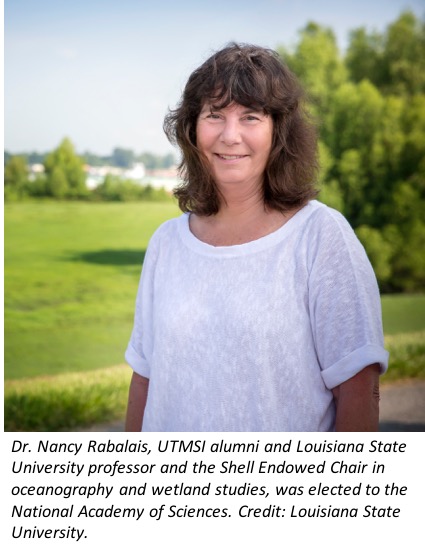 The ocean is in her blood. Since arriving to Corpus Christi in her teen years, Dr. Nancy Rabalais has been drawn to the coast. She was recently elected as one of the newest National Academy of Sciences members recognized for her distinguished achievements in original research. Now at Louisiana State University, Dr. Rabalais got her start in Corpus Christi transitioning from Del Mar College to studying sea squirts at Texas A&I in Kingsville, now Texas A&M, where she received her bachelor of science and master in science. She then came to the University of Texas Marine Science Institute in Port Aransas in 1976 where she identified organisms from continental shelf mud samples as part of the South Texas Outer Continental Shelf environmental assessment. She returned to graduate school in 1979 where she received her Ph.D. in zoology studying fiddler crab adaptations. She then turned her thirst for knowledge and love of science to the Gulf of Mexico, where she began at the Louisiana Universities Marine Consortium in 1983.
The ocean is in her blood. Since arriving to Corpus Christi in her teen years, Dr. Nancy Rabalais has been drawn to the coast. She was recently elected as one of the newest National Academy of Sciences members recognized for her distinguished achievements in original research. Now at Louisiana State University, Dr. Rabalais got her start in Corpus Christi transitioning from Del Mar College to studying sea squirts at Texas A&I in Kingsville, now Texas A&M, where she received her bachelor of science and master in science. She then came to the University of Texas Marine Science Institute in Port Aransas in 1976 where she identified organisms from continental shelf mud samples as part of the South Texas Outer Continental Shelf environmental assessment. She returned to graduate school in 1979 where she received her Ph.D. in zoology studying fiddler crab adaptations. She then turned her thirst for knowledge and love of science to the Gulf of Mexico, where she began at the Louisiana Universities Marine Consortium in 1983.
Rabalais went on to identify the “Dead Zone” in the Gulf of Mexico. Since the mid-1980s, she has been characterizing the dynamics of the large region in the northern Gulf of Mexico where the oxygen levels in the bottom waters are so low in spring and summer that fish, shrimp and crabs cannot survive. Her research has documented and tracked linkages between oxygen depletion, or hypoxia, in the Gulf of Mexico to landscape use and increasing nitrogen and phosphorus delivered to the Mississippi River. These findings have led to federal legislation concerning the diminished water quality. “My humble research beginnings in 1976 have grown into a ‘village,’ which is an interdisciplinary science approach that is essential to tackle global problems such as improving environmental quality. I share this honor of being elected to the National Academy of Sciences with all of my colleagues,” she said.
Rabalais is also among the 59 women who have been elected, the most women elected in a single year to the National Academy of Sciences. “The historic number of women elected this year reflects the critical contributions that they are making in many fields of science, as well as a concerted effort by our Academy to recognize those contributions and the essential value of increasing diversity in our ranks,” said National Academy of Sciences President Marcia McNutt. “I am pleased to welcome all of our new members, and I look forward to engaging with them in the work of the National Academies.”
The body of work that Rabalais has created about the Gulf of Mexico has dramatically advanced our knowledge about the impact of humans on our natural ecosystems. Her research has been integral in supporting legislation to improve the health and ecosystems of the Gulf of Mexico.